Coin Facts to Upload Pictures of Coins
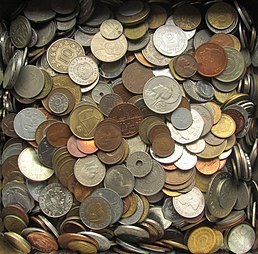
A pick of metal coins.
A coin is a small, apartment, (commonly, depending on the country or value) circular piece of metal or plastic used primarily every bit a medium of exchange or legal tender. They are standardized in weight, and produced in big quantities at a mint in order to facilitate trade. They are almost ofttimes issued by a government. Coins oft have images, numerals, or text on them. Obverse and its reverse, contrary, refer to the two flat faces of coins and medals. In this usage, obverse ways the front end face of the object and contrary means the back face. The obverse of a coin is normally chosen heads, considering it often depicts the head of a prominent person, and the reverse tails.
Coins are usually metal or an alloy, or sometimes made of manmade materials. They are commonly disc shaped. Coins made of valuable metal are stored in large quantities as bullion coins. Other coins are used as money in everyday transactions, circulating aslope banknotes. Usually the highest value money in circulation (excluding bullion coins) is worth less than the lowest-value note. In the terminal hundred years, the confront value of circulation coins has occasionally been lower than the value of the metal they contain, for example due to aggrandizement. If the divergence becomes significant, the issuing dominance may decide to withdraw these coins from circulation, perchance issuing new equivalents with a different composition, or the public may decide to melt the coins downward or hoard them (run into Gresham's constabulary).
Exceptions to the dominion of face value being higher than content value also occur for some bullion coins made of copper, silver, or gold (and, rarely, other metals, such as platinum or palladium), intended for collectors or investors in precious metals. Examples of modern gold collector/investor coins include the British sovereign minted past the United Kingdom, the American Gilded Eagle minted by the United States, the Canadian Aureate Maple Leaf minted by Canada, and the Krugerrand, minted by South Africa. While the Eagle, and Sovereign coins have nominal (purely symbolic) confront values, the Krugerrand does not.
Historically, a considerable diverseness of coinage metals (including alloys) and other materials (e.g. porcelain) accept been used to produce coins for circulation, collection, and metal investment: bullion coins often serve as more convenient stores of bodacious metal quantity and purity than other bullion.[ane]
Ancient History [edit]
Bullion and unmarked metals [edit]
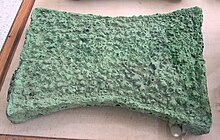
An oxhide ingot from Crete. Late Statuary Age metal ingots were given standard shapes, such as the shape of an "ox-hide", suggesting that they represented standardized values.
Metal ingots, silver bullion or unmarked confined were probably in utilize for commutation among many of the civilizations that mastered metallurgy. The weight and purity of bullion would be the key determinant of value. In the Achaemenid Empire in the early on 6th century BCE, coinage was yet unknown, and barter and to some extent silverish bullion was used instead for trade.[2] The practice of using silver bars for currency as well seems to accept been current in Central Asia from the 6th century BCE.[three] Coins were an evolution of "currency" systems of the Late Bronze Historic period, where standard-sized ingots, and tokens such as knife money, were used to store and transfer value.
Tongbei in Bronze Age Communist china (circa 1100 BCE) [edit]
In the late Chinese Statuary Age, standardized cast tokens were made, such every bit those discovered in a tomb near Anyang.[4] [5] These were replicas in bronze of before Chinese currency, cowrie shells, so they were named Bronze Shell.[6]
Iron Age [edit]
Lydian and Ionian electrum coins (circa 600 BCE) [edit]


The primeval inscribed coinage: electrum coin of Phanes from Ephesus, 625–600 BCE. Obverse: Stag grazing right, ΦΑΝΕΩΣ (retrograde). Reverse: 2 incuse punches, each with raised intersecting lines.[7]
The earliest coins are mostly associated with Iron Historic period Anatolia of the late 7th century BCE, and especially with the kingdom of Lydia.[eight] Early electrum coins (an alluvial alloy of gold and silverish, varying wildly in proportion, and commonly almost 40–55% gold) were not standardized in weight, and in their earliest phase may have been ritual objects, such as badges or medals, issued past priests.[9] The unpredictability of the limerick of naturally occurring electrum unsaid that it had a variable value, which profoundly hampered its development.[10]
About of the early Lydian coins include no writing ("myth" or "inscription"), but an paradigm of a symbolic animal. Therefore, the dating of these coins relies primarily on archaeological evidence, with the most commonly cited evidence coming from excavations at the Temple of Artemis at Ephesus, likewise called the Ephesian Artemision (which would later evolve into one of the Seven Wonders of the Ancient Earth), site of the earliest known eolith of electrum coins.[seven] Considering the oldest lion head "coins" were discovered in that temple, and they do non announced to have been used in commerce[ commendation needed ], these objects may not have been coins but badges or medals issued by the priests of that temple[ citation needed ]. Anatolian Artemis was the Πὀτνια Θηρῶν (Potnia Thêrôn, "Mistress of Animals"), whose symbol was the stag. Information technology took some fourth dimension before ancient coins were used for commerce and merchandise[ citation needed ]. Even the smallest-denomination electrum coins, peradventure worth well-nigh a twenty-four hour period's subsistence, would have been too valuable for buying a loaf of bread.[eleven] Maybe the start coins to be used for retailing on a large-scale basis were probable small silver fractions, Hemiobol, Ancient Greek coinage minted by the Ionian Greeks in the late 6th century BCE.[12]
In contrast Herodotus mentioned the innovation made past the Lydians:[10]
"So far as we have any knowledge, they [the Lydians] were the offset people to introduce the use of gold and silvery coins, and the first who sold goods past retail"
—Herodotus, I94[10]
And both Aristotle (fr. 611,37, ed. V. Rose) and Pollux (Onamastikon 9.83), mention that the offset issuer of coinage was Hermodike/Demodike of Cyme.[13] [fourteen] Cyme was a city in Aeolia, nearby Lydia.
"Some other example of local pride is the dispute about coinage, whether the beginning one to strike it was Pheidon of Argos, or Demodike of Kyme (who was wife of Midas the Phrygian and daughter of Male monarch Agammemnon of Kyme), or Erichthonios and Lycos of Athens, or the Lydians (as Xenophanes says) or the Naxians (as Anglosthenes thought)"
—Julius Pollux, Onamastikon Nine.83[fifteen]
Many early Lydian and Greek coins were minted under the authority of private individuals and are thus more akin to tokens or badges than to mod coins,[sixteen] though due to their numbers information technology is axiomatic that some were official land issues. The earliest inscribed coins are those of Phanes, dated to 625–600 BC from Ephesus in Ionia, with the legend ΦΑΕΝΟΣ ΕΜΙ ΣHΜΑ (or like) ("I am the badge/sign/marker of Phanes/calorie-free") or but bearing the name ΦΑΝΕΟΣ ("of Phanes").
The first electrum coins issued past a monarch are those minted past king Alyattes of Lydia (died c. 560 BCE), for which reason this king is sometimes mentioned equally the originator of coinage.[17]
Croesus: Pure gold and argent coins [edit]

Gilded Croeseid, minted by King Croesus circa 561–546 BCE. (10.vii grams, Sardis mint)

Silver Croeseid, minted by Male monarch Croesus, circa 560–546 BCE (x.7 grams, Sardis mint)
The successor of Alyattes, rex Croesus (r. c. 560–546 BCE), became associated with great wealth in Greek historiography. He is credited with issuing the Croeseid, the first true golden coins with a standardized purity for full general circulation.[10] and the globe's first bimetallic budgetary system c. 550 BCE.[ten]
Coins spread quickly in the 6th and 5th centuries BCE, leading to the development of Ancient Greek coinage and Achaemenid coinage, and farther to Illyrian coinage.[18]
Standardized Roman currency was used throughout the Roman Empire. Important Roman aureate and silver coins were connected into the Heart Ages (see Gold dinar, Solidus, Aureus, Denarius). Aboriginal and early medieval coins in theory had the value of their metallic content, although there have been many instances throughout history of governments inflating their currencies past debasing the metal content of their coinage, so that the inferior coins were worth less in metallic than their face value. Fiat money first arose in medieval China, with the jiaozi paper money. Early on paper money was introduced in Europe in the later Middle Ages, but some coins continued to have the value of the gold or silver they contained throughout the Early Mod menstruum. The penny was minted as a silvery coin until the 17th century.
Achaemenid coinage (546–330 BCE) [edit]

The outset type of Siglos (Blazon I: "King with bow and arrows", upper body of the king only), from the fourth dimension of Darius I. Circa 520–505 BCE

Daric gold coin (c.490 BCE), one of the most successful of Artifact.
When Cyrus the Swell (550–530 BC) came to ability, coinage was unfamiliar in his realm. Castling and to some extent silverish bullion was used instead for merchandise.[ii] The practice of using silvery confined for currency also seems to have been current in Primal Asia from the 6th century.[three]
Cyrus the Neat introduced coins to the Persian Empire after 546 BCE, following his conquest of Lydia and the defeat of its king Croesus, who had put in identify the first coinage in history. With his conquest of Lydia, Cyrus acquired a region in which coinage was invented, developed through advanced metallurgy, and had already been in apportionment for about fifty years, making the Lydian Kingdom one of the leading trade powers of the fourth dimension.[two] It seems Cyrus initially adopted the Lydian coinage as such, and continued to strike Lydia'south lion-and-bull coinage.[2]
Original coins of the Achaemenid Empire were issued from 520 BCE – 450 BCE to 330 BCE. The Persian Daric was the first truly Achaemenid gold coin which, along with a like silver money, the Siglos, represented the bimetallic monetary standard of the Achaemenid Farsi Empire.[xix]
Coinage of Southern asia under the Achaemenid Empire [edit]

The Achaemenid Empire already reached the doors of India during the original expansion of Cyrus the Slap-up, and the Achaemenid conquest of the Indus Valley is dated to c. 515 BCE under Darius I.[2] An Achaemenid administration was established in the expanse. The Kabul hoard, as well called the Chaman Hazouri hoard,[22] is a coin hoard discovered in the vicinity of Kabul, Afghanistan, containing numerous Achaemenid coins as well as many Greek coins from the 5th and 4th centuries BCE.[21] The deposit of the hoard is dated to the Achaemenid period, in approximately 380 BCE.[23] The hoard as well contained many locally produced silver coins, minted past local regime under Achaemenid rule.[24] Several of these issues follow the "western designs" of the facing bull heads, a stag, or Persian column capitals on the obverse, and incuse punch on the reverse.[24] [25]
According to numismatist Joe Cribb, these finds propose that the idea of coinage and the use of punch-marked techniques was introduced to India from the Achaemenid Empire during the 4th century BCE.[26] More Achaemenid coins were as well found in Pushkalavati and in Bhir Mound.[27]
-

Punch-marked money minted in the Kabul Valley nether Achaemenid administration. Circa 500–380 BCE, or c.350 BCE.[28] [21]
-

Gandharan "bent-bar" punch-marked money minted under Achaemenid administration, of the blazon establish in large quantities in the Chaman Hazouri and the Bhir Mound hoards.
-
Greek Archaic coinage (until about 480 BCE) [edit]

Silverish stater of Aegina, 550–530 BCE. Obv. Sea turtle with large pellets downwardly middle. Rev. incuse square punch with eight sections.

According to Aristotle (fr. 611,37, ed. V. Rose) and Pollux (Onamastikon 9.83), the starting time issuer of Greek coinage was Hermodike of Kyme.[13]
A small percentage of early Lydian/Greek coins have a fable.[thirty] The nearly ancient inscribed coin known is from nearby Caria. This money has a Greek legend reading phaenos emi sema [31] interpreted variously as "I am the badge of Phanes", or "I am the sign of calorie-free".[32] The Phanes coins are among the earliest of Greek coins; a hemihekte of the issue was institute in the foundation deposit of the temple of Artemis at Ephesos (the oldest deposit of electrum coins discovered). One supposition is that Phanes was a mercenary mentioned by Herodotus, another that this coin is associated with the primeval god Phanes or "Phanes" might have been an epithet of the local goddess identified with Artemis. Barclay Five. Head constitute these suggestions unlikely and idea it more probably "the proper name of some prominent denizen of Ephesus".[33]
Another candidate for the site of the earliest coins is Aegina, where Chelone ("turtle") coins were start minted circa 700 BCE.[34] Coins from Athens and Corinth appeared shortly thereafter, known to exist at least since the belatedly 6th century BCE.[35]
-

Coin of Phaselis, Lycia. Circa 550–530/twenty BCE.
-

Money of Lycia. Circa 520–470/sixty BCE.
-

Lycia money. Circa 520-470 BCE. Struck with worn obverse dice.[36]
Antiquity [edit]
Classical Greek antiquity (480 BCE~) [edit]

Tetradrachm of Athens
(c. 454–404 BCE)
Obverse: a portrait of Athena, patron goddess of the metropolis, in helmet
Reverse: the owl of Athens, with an olive sprig and the inscription "ΑΘΕ", short for ΑΘΕΝΑΙΟΝ, "of the Athenians"
The Classical menstruum saw Greek coinage attain a loftier level of technical and artful quality. Larger cities at present produced a range of fine silvery and gilt coins, nigh begetting a portrait of their patron god or goddess or a legendary hero on i side, and a symbol of the city on the other. Some coins employed a visual pun: some coins from Rhodes featured a rose, since the Greek word for rose is rhodon. The use of inscriptions on coins too began, usually the name of the issuing metropolis.
The wealthy cities of Sicily produced some peculiarly fine coins. The large silverish decadrachm (10-drachm) coin from Syracuse is regarded by many collectors equally the finest coin produced in the aboriginal world, perhaps ever. Syracusan bug were rather standard in their imprints, one side begetting the head of the nymph Arethusa and the other ordinarily a victorious quadriga. The tyrants of Syracuse were fabulously rich, and office of their public relations policy was to fund quadrigas for the Olympic chariot race, a very expensive undertaking. As they were ofttimes able to finance more than one quadriga at a time, they were frequent victors in this highly prestigious event. Syracuse was one of the epicenters of numismatic art during the classical period. Led by the engravers Kimon and Euainetos, Syracuse produced some of the finest coin designs of antiquity.
Amid the beginning centers to produce coins during the Greek colonization of mainland Southern Italian republic (Magna Graecia) were Paestum, Crotone, Sybaris, Caulonia, Metapontum, and Taranto. These ancient cities started producing coins from 550BCE to 510BCE.[37] [38]
Amisano, in a full general publication, including the Etruscan coinage, attributing it the start to well-nigh 560 BCE in Populonia, a chronology that would leave out the contribution of the Greeks of Magna Graecia and aspect to the Etruscans the burden of introducing the coin in Italia. In this piece of work, abiding reference is made to classical sources, and credit is given to the origin of the Etruscan Lydia, a source supported by Herodotus, and likewise to the invention of coin in Lydia.[39]
-

Aegina coin blazon, incuse skew design. Circa 456/45–431 BCE.
-

Coin from Korkyra, circa 350/30–290/70 BCE.
-

Coin of Republic of cyprus, circa 450 BCE.
Appearance of dynastic portraiture (fifth century BCE) [edit]

Although many of the beginning coins illustrated the images of various gods, the first portraiture of actual rulers appears with the coinage of Lycia in the fifth century BCE.[40] [41] No ruler had dared illustrating his own portrait on coinage until that time.[41] The Achaemenids had been the start to illustrate the person of their king or a hero in a stereotypical manner, showing a bust or the full body simply never an actual portrait, on their Sigloi and Daric coinage from circa 500 BCE.[41] [42] [43] A slightly earlier candidate for the showtime portrait-coin is Themistocles the Athenian general, who became a Governor of Magnesia on the Meander circa 465–459 BCE for the Achaemenid Empire,[44] although there is some doubt that his coins may have represented Zeus rather than himself.[45] Themistocles may have been in a unique position in which he could transfer the notion of individual portraiture, already electric current in the Greek world, and at the same time wield the dynastic power of an Achaemenid dynasty who could issue his own coins and illustrate them as he wished.[46] From the time of Alexander the Great, portraiture of the issuing ruler would then become a standard, generalized, feature of coinage.[41]
-

Coin of Themistocles equally Governor of Magnesia. Obv: Barley grain. Rev: Possible portrait of Themistocles. Circa 465–459 BC.[47]
-

Portrait of Lycian ruler Kherei wearing the Persian cap on the opposite of his coins (ruled 410–390 BCE).
-

Portrait of Lycian ruler Erbbina wearing the Persian cap on the opposite of his coins (ruled 390–380 BCE).
-

Portrait of Lycian ruler Perikles facing (ruled 380-360 BCE).
Indian coins (circa 400 BCE–100 CE) [edit]

The Karshapana is the primeval dial-marked coin institute in India, produced from at least the mid-fourth century BCE, and possibly equally early every bit 575 BCE,[48] influenced by similar coins produced in Gandhara under the Achaemenid empire, such equally those of the Kabul hoard,[49] or other examples found at Pushkalavati and in Bhir Mound.[27]
Chinese round coins (350 BCE~) [edit]

In China, early round coins appeared in the quaternary century BCE and were adopted for all Communist china by Emperor Qin Shi Huang Di at the end of third century BCE.[50] The circular coin, the precursor of the familiar cash coin, circulated in both the spade and pocketknife money areas in the Zhou flow, from effectually 350 BCE. Apart from 2 small and presumably late coins from the State of Qin, coins from the spade coin area accept a circular hole and refer to the jin and liang units. Those from the pocketknife money expanse have a foursquare hole and are denominated in hua (化).
Although for discussion purposes the Zhou coins are divided upwards into categories of knives, spades, and round coins, it is apparent from archaeological finds that virtually of the various kinds circulated together. A hoard establish in 1981, near Hebi in north Henan province, consisted of: 3,537 Gong spades, 3 Anyi arched pes spades, 8 Liang Dang Prevarication spades, 18 Liang square human foot spades and ane,180 Yuan round coins, all contained in iii clay jars.
Hellenistic catamenia (320 BCE – 30 CE) [edit]

Posthumous Alexander the Great tetradrachm from Temnos, Aeolis. Dated 188–170 BCE. Obverse: Alexander the Great equally Herakles facing correct wearing the nemean lionskin. Opposite: Zeus seated on throne to the left holding eagle in right hand and scepter in left; in left field PA monogram and angular sigma in a higher place grape vine arching over oinochoe; ALEXANDROU vertical in correct field. Reference: Cost 1678.
The Hellenistic period was characterized by the spread of Greek civilisation across a large part of the known world. Greek-speaking kingdoms were established in Egypt and Syria, and for a time also in Iran and as far due east equally what is now Afghanistan and northwestern India. Greek traders spread Greek coins across this vast area, and the new kingdoms soon began to produce their ain coins. Because these kingdoms were much larger and wealthier than the Greek metropolis states of the classical catamenia, their coins tended to be more mass-produced, as well every bit larger, and more often in gold. They oft lacked the aesthetic delicacy of coins of the earlier menstruum.
Withal, some of the Greco-Bactrian coins, and those of their successors in Bharat, the Indo-Greeks, are considered the finest examples of Greek numismatic art with "a nice blend of realism and idealization", including the largest coins to be minted in the Hellenistic world: the largest gold coin was minted by Eucratides (reigned 171–145 BCE), the largest silver coin past the Indo-Greek king Amyntas Nikator (reigned c. 95–90 BCE). The portraits "prove a degree of individuality never matched by the often banal depictions of their royal contemporaries further West" (Roger Ling, "Hellenic republic and the Hellenistic Globe").
Roman menses (290 BCE~) [edit]
Coinage followed Greek colonization and influence first around the Mediterranean and before long afterwards to North Africa (including Egypt), Syria, Persia, and the Balkans.[52] Coins came late to the Roman Republic compared with the rest of the Mediterranean, especially Greece and Asia Minor where coins were invented in the 7th century BCE. The currency of central Italian republic was influenced by its natural resources, with statuary being abundant (the Etruscans were famous metal workers in statuary and iron) and silver ore beingness deficient. The coinage of the Roman Republic started with a few silver coins apparently devised for merchandise with Celtic in northern Italy and the Greek colonies in Southern Italy, and heavy cast bronze pieces for employ in Fundamental Italia. The get-go Roman coins, which were crude, heavy cast bronzes, were issued c. 289 BCE.[53] Amisano, in a full general publication, including the Etruscan coinage, attributing it the commencement to about 550 BCE in Populonia, a chronology that would leave out the contribution of the Greeks of Magna Graecia and aspect to the Etruscans the burden of introducing the coin in Italy. In this piece of work, constant reference is made to classical sources, and credit is given to the origin of the Etruscan Lydia, a source supported past Herodotus, and as well to the invention of coin in Lydia.[39]
Heart Ages [edit]
| | This section needs expansion with: more details from the manufactures in farther information. You can aid by adding to it. (September 2021) |
The borders of the Roman Empire divided Europe into two monetary zones in the early centuries of the first millennium a.d.: a southern and western zone, in which coins were minted and circulated more than or less regularly equally an integral part of the economic system, and a northern and eastern zone, which made no coins of its ain and imported coins sporadically as a event of various economical and other interactions. The same budgetary split of Europe, roughly forth the Rhine and Danube River valleys, survived the Roman Empire'south political breakup and was maintained virtually until the end of the millennium. [54]
The kickoff European coin to use Arabic numerals to engagement the yr in which the coin was minted was the St. Gall silverish Plappart of 1424.[55]
Mod history [edit]
| | This section needs expansion. You can assist past adding to information technology. (September 2021) |
-
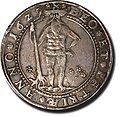
-

Japanese local currency Genbun Inari Koban Kin, c. 1736–1741
-

Value [edit]
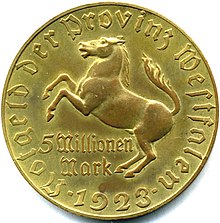
Five million mark coin (Weimar Republic, 1923). Despite its high denomination, this coin'south monetary value dropped to a tiny fraction of a U.s. cent past the terminate of 1923, essentially less than the value of its metallic content.
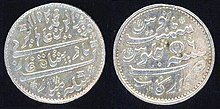
Currency [edit]
Most coins before long are made of a base metal, and their value comes from their status as fiat money. This means that the value of the coin is decreed by government fiat (law), and thus is determined by the gratuitous market only in as much as national currencies are used in domestic trade and likewise traded internationally on foreign exchange markets. Thus, these coins are monetary tokens, simply as paper currency is: they are usually non backed past metal, but rather past some form of regime guarantee. Some have suggested that such coins not be considered to be "truthful coins" (come across below). Thus, there is very little economical difference betwixt notes and coins of equivalent face value.
Coins may be in circulation with fiat values lower than the value of their component metals, but they are never initially issued with such value, and the shortfall only arises over time due to inflation, every bit market values for the metallic overtake the fiat alleged face value of the coin. Examples are the pre-1965 US dime, quarter, half dollar, and dollar (nominally containing slightly less than a tenth, quarter, half, and full ounce of silver, respectively), Us nickel, and pre-1982 US penny. Equally a result of the increase in the value of copper, the Us greatly reduced the amount of copper in each penny. Since mid-1982, United states pennies are fabricated of 97.five% zinc, with the remaining 2.v% being a blanket of copper. Extreme differences between fiat values and metal values of coins cause coins to be hoarded or removed from circulation by illicit smelters in order to realize the value of their metal content. This is an example of Gresham'due south law. The United states Mint, in an attempt to avoid this, implemented new interim rules on December fourteen, 2006, bailiwick to public comment for thirty days, which criminalized the melting and export of pennies and nickels.[56] Violators can be fined up to $10,000 and/or imprisoned for up to 5 years.
Collector'south items [edit]
A money's value as a collector's item or as an investment generally depends on its condition, specific historical significance, rarity, quality, beauty of the design and full general popularity with collectors. If a money is greatly defective in all of these, information technology is unlikely to be worth much. The value of bullion coins is as well influenced to some extent by those factors, but is largely based on the value of their gold, silver, or platinum content. Sometimes non-monetized bullion coins such equally the Canadian Maple Leaf and the American Gold Eagle are minted with nominal face values less than the value of the metal in them, but as such coins are never intended for apportionment, these face values have no relevance.
Collector catalogs ofttimes include information about coins to assists collectors with identifying and grading. Additional resources tin can be found online for collectors These are collector clubs, collection management tools, marketplaces,[57] trading platforms, and forums,
Media of expression [edit]
Coins can exist used as creative media of expression – from fine art sculpture to the penny machines that tin can exist found in near amusement parks. In the Lawmaking of Federal Regulations (CFR) in the United States there are some regulations specific to nickels and pennies that are informative on this topic. 31 CFR § 82.1 forbids unauthorized persons from exporting, melting, or treating whatsoever 5 or 1 cent coins.[58]
This has been a particular problem with nickels and dimes (and with some comparable coins in other currencies) considering of their relatively low face value and unstable article prices. For a while,[ when? ] the copper in US pennies was worth more than one cent, then people would hoard pennies and so melt them downward for their metal value. It cost more than confront value to manufacture pennies or nickels, then whatever widespread loss of the coins in circulation could be expensive for the Usa Treasury. This was more of a problem when coins were withal made of precious metals like silver and gold, and then strict laws against amending make more than sense historically. [ citation needed ]
31 CFR § 82.2(b) goes on to state that: "The prohibition contained in § 82.i against the treatment of 5-cent coins and one-cent coins shall not apply to the treatment of these coins for educational, amusement, novelty, jewelry, and similar purposes as long as the volumes treated and the nature of the treatment makes it clear that such treatment is not intended as a means past which to profit solely from the value of the metal content of the coins."[59]
Debasement and clipping [edit]


Alexander the Cracking Tetradrachm from the Temnos Mint, dated circa 188–170 BCE
Throughout history, monarchs and governments have often created more coinage than their supply of precious metals would allow if the coins were pure metal. Past replacing some fraction of a coin'due south precious metallic content with a base metal (often copper or nickel), the intrinsic value of each individual coin was reduced (thereby "debasing" the money), allowing the coining authority to produce more coins than would otherwise be possible. Debasement occasionally occurs in gild to make the coin physically harder and therefore less likely to be worn down as quickly, simply the more usual reason is to profit from the difference between confront value and metal value. Debasement of money about e'er leads to cost inflation. Sometimes price controls are at the same time too instituted by the governing dominance, but historically these have more often than not proved unworkable.
The United states is unusual in that it has simply slightly modified its coinage organisation (except for the images and symbols on the coins, which have changed a number of times) to accommodate two centuries of inflation. The one-cent money has changed little since 1856 (though its limerick was changed in 1982 to remove virtually all copper from the coin) and still remains in circulation, despite a greatly reduced purchasing power. On the other terminate of the spectrum, the largest coin in common apportionment is valued at 25 cents, a very low value for the largest denomination money compared to many other countries. Increases in the prices of copper, nickel, and zinc meant that both the United states one- and 5-cent coins became worth more for their raw metal content than their face (fiat) value. In particular, copper one-cent pieces (those dated prior to 1982 and some 1982-dated coins) contained about two cents' worth of copper.
Some denominations of circulating coins that were formerly minted in the The states are no longer made. These include coins with a face up value of a half cent, two cents, three cents, and 20 cents. (The one-half dollar and dollar coins are yet produced, but generally for vending machines and collectors.) In the past, the Us also coined the following denominations for circulation in gilt: One dollar, $2.50, 3 dollars, five dollars, x dollars, and xx dollars. In addition, cents were originally slightly larger than the modern quarter and weighed well-nigh half an ounce, while five-cent coins (known then as "half dimes") were smaller than a dime and made of a silver alloy. Dollar coins were also much larger, and weighed approximately an ounce. One-dollar gilded coins are no longer produced and rarely used. The US also bug bullion and commemorative coins with the following denominations: 50¢, $1, $5, $10, $25, $50, and $100.
Circulating coins commonly suffered from "shaving" or "clipping": the public would cut off small-scale amounts of precious metallic from their edges to sell it and and then pass on the mutilated coins at full value.[60] Unmilled British sterling silver coins were sometimes reduced to almost half their minted weight. This class of debasement in Tudor England was commented on past Sir Thomas Gresham, whose name was later attached to Gresham's law. The monarch would take to periodically recall circulating coins, paying simply the bullion value of the silverish, and reminting them. This, besides known as recoinage, is a long and difficult process that was done but occasionally.[61] Many coins take milled or reeded edges, originally designed to brand information technology easier to detect clipping.
Other uses [edit]
Some convicted criminals from the British Isles who were sentenced to transportation to Commonwealth of australia in the 18th and 19th centuries used coins to get out messages of remembrance to loved ones left behind in Britain. The coins were defaced, smoothed and inscribed, either by stippling or engraving, with sometimes touching words of loss. These coins were called "captive love tokens" or "leaden hearts".[62] Some of these tokens are in the collection of the National Museum of Commonwealth of australia.
Modern features [edit]



French 1992 twenty Franc Tri-Metallic coin

Bimetallic Egyptian one pound coin featuring King Tutankhamen
The side of a coin carrying an prototype of a monarch, other dominance (see Listing of people on coins), or a national emblem is called the obverse (colloquially, heads); the other side, carrying various types of data, is called the reverse (colloquially, tails). The year of minting is unremarkably shown on the obverse, although some Chinese coins, about Canadian coins, the pre-2008 British 20p coin, the post-1999 American quarter, and all Japanese coins are exceptions.
The relation of the images on the obverse and opposite of a coin is the coin's orientation. If the paradigm on the obverse of the money is right side up and turning the coin left or correct on its vertical axis reveals that the reverse of the coin is also correct side up, then the coin is said to accept medallic orientation—typical of the Euro and pound sterling; if, withal, turning the money left or right shows that the reverse image is upside downwardly, then the coin is said to accept money orientation, characteristic of the United States dollar coin.
Bimetallic coins are sometimes used for higher values and for commemorative purposes. In the 1990s, France used a tri-metal money. Common circulating bimetallic examples include the €1, €2, British £1, £2 and Canadian $2 and several peso coins in Mexico.
The exergue is the space on a money below the main design, often used to show the coin'south date, although it is sometimes left blank or contains a mint mark, privy mark, or some other decorative or informative design characteristic. Many coins do not have an exergue at all, especially those with few or no legends, such as the Victorian bun penny.
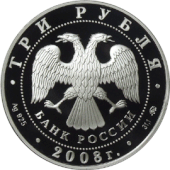
iii Rubles proof coin of Russian federation, minted in 2008
Not all coins are round; they come in a diverseness of shapes. The Australian 50-cent coin, for case, has twelve apartment sides. Some coins have wavy edges, e.g. the $2 and xx-cent coins of Hong Kong and the 10-cent coins of Bahama islands. Some are foursquare-shaped, such as the xv-cent coin of the Bahama islands and the 50-cent coin from Aruba. During the 1970s, Swazi coins were minted in several shapes, including squares, polygons, and wavy edged circles with viii and 12 waves.
-

Scalloped coin of State of israel
-
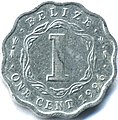
1996 one cent money from Belize
-
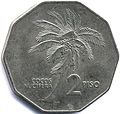
Decagonal two Piso Philippine coin 1990
Some other coins, like the British 20 and l pence coins and the Canadian Loonie, have an odd number of sides, with the edges rounded off. This way the money has a constant diameter, recognizable by vending machines whichever management it is inserted.
A triangular coin with a face value of £5 (produced to commemorate the 2007/2008 Tutankhamun exhibition at The O2 Loonshit) was commissioned by the Isle of man: it became legal tender on 6 Dec 2007.[63] Other triangular coins issued earlier include: Cabinda coin, Bermuda coin, two Dollar Melt Islands 1992 triangular coin, Uganda Millennium Money and Polish Sterling-Silvery 10-Zloty Coin.
Some medieval coins, called bracteates, were and then thin they were struck on only 1 side.
Many coins over the years have been manufactured with integrated holes such as Chinese "greenbacks" coins, Japanese coins, Colonial French coins, etc. This may have been done to permit their existence strung on cords, to facilitate storage and being carried. Present, holes help to differentiate coins of like size and metal, such as the Japanese 50 yen and 100 yen coin.
-
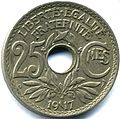
1917 French coin with integrated pigsty
-
Chinese greenbacks coin, 1102–1106
-

1941 Palestine coin
-

Modern-day Japanese 50-yen coin
-

1924 E African coin

Holographic coin from Liberia features the Statue of Liberty (Liberty Enlightening the Globe)
The Regal Canadian Mint is now able to produce holographic-effect aureate and silver coinage. Nonetheless, this procedure is not limited to only bullion or commemorative coinage. The 500 yen coin from Nippon was subject to a massive corporeality of counterfeiting. The Japanese authorities in response produced a circulatory money with a holographic epitome.
The Regal Canadian Mint has also released several coins that are colored, the get-go of which was in commemoration of Remembrance Day. The subject was a colored poppy on the reverse of a 25-cent piece minted through a patented process.[64]
An example of non-metal composite coins (sometimes incorrectly called plastic coins) was introduced into circulation in Transnistria on 22 Baronial 2014. Most of these coins are also not-circular, with different shapes corresponding to unlike coin values.[65]
For a list of many pure metallic elements and their alloys which have been used in actual circulation coins and for trial experiments, see coinage metals.[66]
Physics and chemistry [edit]

Flipping [edit]
To flip a coin to see whether information technology lands heads or tails is to use it as a two-sided die in what is known in mathematics equally a Bernoulli trial: if the probability of heads (in the parlance of Bernoulli trials, a "success") is exactly 0.5, the coin is fair.
Spinning [edit]
Coins can also be spun on a apartment surface such as a table. This results in the following phenomenon: every bit the money falls over and rolls on its edge, information technology spins faster and faster (formally, the precession charge per unit of the symmetry axis of the coin, i.e., the axis passing from ane confront of the coin to the other) before coming to an sharp cease. This is mathematically modeled as a finite-time singularity – the precession rate is accelerating to infinity, before it of a sudden stops, and has been studied using high speed photography and devices such as Euler'due south Disk. The slowing down is predominantly caused by rolling friction (air resistance is minor), and the singularity (divergence of the precession rate) can be modeled as a power police force with exponent approximately −ane/3.[67]
Aroma [edit]
Fe and copper coins accept a characteristic metallic smell that is produced upon contact with oils in the skin. Perspiration is chemically reduced upon contact with these metals, which causes the skin oils to decompose, forming with iron the volatile molecule 1-octen-3-i.[68]
Regional examples [edit]
Philippines [edit]
| | This section needs expansion. Y'all can help by adding to it. (December 2021) |
Jose Rizal sent a parcel to Ferdinand Blumentritt in Bohemia in September 1887. Six smokes of quality Philippine tobacco, an early Philippine lighter or sulpakan, sampaguita and kamuning flowers to conbat the unpleasant odor of called-for tobacco, and a modest piece of gold from a trove discovered in a jar excavated in Mandaluyoung were among the gifts from Calamba. This gold coin, according to Rizal, was the ancient Tagalogs' little change. Rizal'south bulletin is virtually certainly a "piloncito", every bit it is now known.

The Piloncitos are tiny engraved gold coins found in the Philippines, forth with the barter rings, which are gold ring-like ingots. These barter rings are bigger than doughnuts in size and are made of pure gilded from the Primitive period (c. 10th to 16th century).[69]
Piloncitos are modest engraved gold coins found in the Philippines. The size of piloncitos can range to as small as 0.09 to 2.65 grams of fine gilt. Piloncitos accept been excavated from Mandaluyong, Bataan, the banks of the Pasig River, Batangas, Marinduque, Samar, Leyte and some areas in Mindanao. Big quantities of piloncitos have been found in Indonesian archaeological sites, which suggests they may not have originated from the Philippines but been imported. However, numerous Spanish accounts country that the gold coins were mined and labored in the Philippines, such equally the following from 1586:
"The people of this island (Luzon) are very skilful in their handling of golden. They weigh information technology with the greatest skill and delicacy that have e'er been seen. The first thing they teach their children is the noesis of gold and the weights with which they weigh it, for there is no other money among them."[70]
See also [edit]
- Bi-metallic coin
- Coin collecting
- Coin counter
- Coin counterfeiting
- Coin magic
- Money sorter
- Currency
- Hanukkah gelt – Chocolate coin
- History of coins
- Legal tender
- Listing of currencies
- List of circulating currencies
- List of mints
- List of most expensive coins
- Mint
- Coin
- Seigniorage
- Token coin
- X-cent money
Notes and references [edit]
- ^ Tony Clayton. "Comprehensive list of metals and their alloys which have been used at various times, in coins for all types of purposes". coinsoftheuk.co.uk. Retrieved 2018-08-fifteen .
- ^ a b c d e Metcalf, William E. (2016). The Oxford Handbook of Greek and Roman Coinage. Oxford University Press. pp. 61–65. ISBN9780199372188.
- ^ a b Discovery of a hoard of currency with argent bars about Malayer, dated circa 600 BCE, with photographs in Bivar, Adrian David Hugh. Hoard of Ingot-Currency of the Median Catamenia from Nūsh-i Jān, near Malayir (1971). pp. 97–111.
- ^ "中國最早金屬鑄幣 商代晚期鑄造銅貝-河南概況". Big5.henan.gov.cn. Archived from the original on 2012-03-17. Retrieved 2012-05-22 .
- ^ Giedroyc, Richard (2006-11-15). The Everything Money Collecting Book: All You Need to Get-go Your Collection …. ISBN9781593375683. Archived from the original on 2013-05-28. Retrieved 2012-05-21 .
- ^ YK Kwan. "A snap shot view of The history of Prc by YK Kwan". Chinesechinese.net. Archived from the original on 2012-05-03. Retrieved 2012-05-21 .
- ^ a b CNG: IONIA, Ephesos. Phanes. Circa 625–600 BC. EL Trite (14mm, 4.67 1000).
- ^ Thou. Kroll, review of G. Le Passenger's La naissance de la monnaie, Schweizerische Numismatische Rundschau lxxx (2001), p. 526. D. Sear, Greek Coins and Their Values Vol. ii, Seaby, London, 1979, p. 317.
- ^ "The Types of Greek Coins" An Archaeological Essay by Percy Gardner 1883 p.42 "Because these and other facts it may be held to be likely, if not admittedly proved, that priests first issued stamped coin, and that the first mints were in Greek temples." [1] [ dead link ]
- ^ a b c d east f Metcalf, William E. (2016). The Oxford Handbook of Greek and Roman Coinage. Oxford University Press. pp. 49–50. ISBN9780199372188.
- ^ "Hoards, Small-scale Change, and the Origin of Capitalism," Journal of the Hellenistic Studies 84 (1964), p. 89
- ^ M. Mitchiner, Ancient Trade and Early on Coinage, Hawkins Publications, London, 2004, p. 214
- ^ a b Muscarella, Oscar White (2013-06-07). Archeology, Artifacts and Antiquities of the Ancient Nigh East: Sites, Cultures, and Proveniences. ISBN978-9004236691.
- ^ Muscarella, Oscar White (15 June 2013). Archaeology, Artifacts and Antiquities of the Ancient Near East: Sites, Cultures, and Proveniences. ISBN978-9004236691.
- ^ Muscarella, Oscar White (15 June 2013). Archaeology, Artifacts and Antiquities of the Ancient Near East: Sites, Cultures, and Proveniences. ISBN978-9004236691.
- ^ G. Hanfmann, pp. 73, 77. R. Seaford, p. 128, points out, "The nearly total lack of … coins in the excavated commercial-industrial areas of Sardis suggests that they were concentrated in the hands of the king and possibly wealthy merchants."
- ^ A. Ramage, "Golden Sardis", King Croesus' Aureate: Excavations at Sardis and the History of Gold Refining, edited by A. Ramage and P. Craddock, Harvard University Printing, Cambridge, 2000, p. 18.
- ^ "Cent". Archived from the original on half dozen March 2015. Retrieved 7 March 2015.
- ^ Michael Alram, "DARIC", Encyclopaedia Iranica, Dec 15, 1994, last updated November 17, 2011
- ^ Bopearachchi, Osmund; Cribb, Joe (1992), "Coins illustrating the History of the Crossroads of Asia", in Errington, Elizabeth; Cribb, Joe; Claringbull, Maggie (eds.), The Crossroads of Asia: transformation in prototype and symbol in the art of aboriginal Afghanistan and Islamic republic of pakistan, Aboriginal India and Iran Trust, pp. 57–59, ISBN978-0-9518399-ane-one,
Coins of this type found in Chaman Hazouri (deposited c.350 BCE) and Bhir Mound hoards (deposited c.300 BCE).
- ^ a b c Bopearachchi & Cribb, Coins illustrating the History of the Crossroads of Asia 1992, pp. 57–59: "The most of import and informative of these hoards is the Chaman Hazouri hoard from Kabul discovered in 1933, which contained royal Achaemenid sigloi from the western part of the Achaemenid Empire, together with a large number of Greek coins dating from the 5th and early quaternary century BCE, including a local simulated of an Athenian tetradrachm, all manifestly taken from circulation in the region."
- ^ Bopearachchi, Money Production and Circulation 2000, pp. 300–301 harvnb mistake: no target: CITEREFBopearachchi,_Coin_Production_and_Circulation2000 (assist)
- ^ Bopearachchi, Coin Product and Circulation 2000, p. 309 and Note 65 harvnb error: no target: CITEREFBopearachchi,_Coin_Production_and_Circulation2000 (help)
- ^ a b Metcalf, William E. (2016). The Oxford Handbook of Greek and Roman Coinage. Oxford Academy Printing. pp. seventy–80. ISBN9780199372188.
- ^ André-Salvini, Béatrice (2005). Forgotten Empire: The World of Ancient Persia. Academy of California Press. p. 208 Coin no.381 for the Persian cavalcade capitals. ISBN9780520247314.
- ^ Cribb, Investigating the introduction of coinage in India 1983, p. 101 harvnb error: no target: CITEREFCribb,_Investigating_the_introduction_of_coinage_in_India1983 (help)
- ^ a b 372. Lot: 658, Lot of two AR bent bars, CNG Coins. Bopearachchi & Cribb, Coins illustrating the History of the Crossroads of Asia 1992, pp. 57–59: "Silvery bent-bar dial-marked coin of Kabul region under the Achaemenid Empire, c.350 BC: Coins of this type found in quantity in Chaman Hazouri and Bhir Mound hoards." (Commentary by Joe Cribb and Osmund Bopearachchi)
- ^ "Extremely Rare Early Silvery from the Kabul Valley", CNG 102, Lot:649, CNG Coins
- ^ "A Truly International Currency", Triton XV, Lot: 1163, ATTICA, Athens Archived 2019-12-25 at the Wayback Machine, CNG Coins
- ^ "Inscriptions and Titles on ancient Greek coins". Snible.org. Archived from the original on 2012-06-08. Retrieved 2012-05-21 .
- ^ "Electrum stater inscribed with the name of Phanes". British Museum. 2011-09-29. Archived from the original on 2012-05-15. Retrieved 2012-05-21 .
- ^ Newton Num. Chron., 1870, p. 238
- ^ Head, Barclay V. (1911). Historia Numorum, A Manual of Greek Numismatics, New and Enlarged Edition. London: Clarendon Press. Retrieved 25 October 2021.
- ^ British Museum Catalogue 11 – Attica Megaris Aegina, 700 – 550 BCE, plate XXIII Archived 2016-03-04 at the Wayback Machine.
- ^ C. Kraay, Primitive and Classical Greek Coins, University of California Printing, Berkeley, 1976.
- ^ CNG: LYCIA. Circa 520–470/sixty BCE. AR Stater (18mm, 9.18 m).
- ^ "Bruttium – Ancient Greek Coins – WildWinds". Retrieved eight September 2014.
- ^ "Lucania – Ancient Greek Coins – WildWinds.com". Retrieved eight September 2014.
- ^ a b Giuseppe Amisano, "Cronologia due east politica monetaria alla luce dei segni di valore delle monete etrusche e romane", in: Panorama numismatico, 49 (genn. 1992), pp. 15–20
- ^ "The earliest attempts at portraiture appear to accept taken identify in Lycia. The heads of various dynasts appear on coins of the fifth century" Carradice, Ian (1978). Ancient Greek Portrait Coins. British Museum Publications. p. two. ISBN9780714108490.
- ^ a b c d West, Shearer; Birmingham), Shearer (2004). Portraiture. OUP Oxford. p. 68. ISBN9780192842589.
- ^ Root, Margaret Cool (1989). "The Persian archer at Persepolis : aspects of chronology, style and symbolism". Revue des Études Anciennes. 91: 43–50. doi:10.3406/rea.1989.4361.
- ^ "One-half-figure of the King: unravelling the mysteries of the earliest Sigloi of Darius I" (PDF). The Celator. 26 (2): 20. February 2012.
- ^ "A rare silverish fraction recently identified as a coin of Themistocles from Magnesia even has a bearded portrait of the nifty human, making it past far the earliest datable portrait money. Other early portraits tin be seen on the coins of Lycian dynasts." Carradice, Ian; Price, Martin (1988). Coinage in the Greek Earth. Seaby. p. 84. ISBN9780900652820.
- ^ Rhodes, P. J. (2011). A History of the Classical Greek World: 478–323 BC. John Wiley & Sons. p. 58. ISBN9781444358582.
- ^ Howgego, Christopher (2002). Ancient History from Coins. Routledge. p. 64. ISBN9781134877843.
- ^ "CNG: IONIA, Magnesia advertizement Maeandrum. Themistokles. Circa 465-459 BC. AR Hemiobol (7mm, 0.37 g, 1h)".
- ^ HARDAKER, TERRY R. (1975). "The origins of coinage in northern Bharat". The Numismatic Chronicle. xv: 200–203. JSTOR 42666515.
- ^ Cribb, Joe (1983). "Investigating the introduction of coinage in India – a review of recent enquiry". Periodical of the Numismatic Club of India. Varanasi. xlv: 85–86, 101.
- ^ Schaps, David (2004). The Invention of Coinage and the Monetization of Aboriginal Greece. University of Michigan Press. p. 235. ISBN978-0472113330.
- ^ "CNG Money 338684".
- ^ Howgego, C. J. (1995). Aboriginal history from coins. Psychology Press. pp. 1–4. ISBN978-0-415-08993-7. Archived from the original on 28 May 2013. Retrieved 4 December 2011.
- ^ Westward. Sayles, Ancient Coin Collecting 3: The Roman World–Politics and Propaganda, Krause Publications, Iola, Wisconsin, 1997
- ^ "Coinage of the Early on Middle Ages | Encyclopedia.com". www.encyclopedia.com . Retrieved 2022-03-22 .
- ^ "Early Dated Coins, Accessed December 2009".
- ^ "United states of america Mint Moves to Limit Exportation & Melting of Coins". The United States Mint. Archived from the original on 2016-05-27. Retrieved 2012-05-22 .
- ^ "Colnect Market Has Been Launched". PR.com . Retrieved 2019-02-20 .
- ^ 31 CFR §82.1, Legal Information Plant, accessed 22 July 2019.
- ^ 31 CFR 82.2(b), Legal Data Found, accessed 22 July 2019.
- ^ Cooper, George (2008). The Origin of Financial Crises. New York: Random House. p. 46. ISBN978-0-307-47345-5.
- ^ Denis R. Cooper The Art and Arts and crafts of Coinmaking. A History of Minting Technology. London: Spink, 1988. ISBN 0-907605-27-3 p.47
- ^ "Captive tokens, National Museum of Australia". Nma.gov.au. 2012-01-25.
- ^ It is unlikely to be spent every bit information technology costs 15GBP to buy – commodity Pyramid money a nightmare for pockets, article by Gary
- ^ Smith, Marie-Danielle (18 January 2018). "Royal Canadian Mint sues Imperial Australian Mint in row over poppy coin printing". The National Post . Retrieved 18 January 2018.
- ^ "Composite coins". Pridnestrovian Republican Depository financial institution. Archived from the original on 4 July 2017. Retrieved 29 Jan 2020.
- ^ Tony Clayton. "Metals Used in Coins and Medals". Tclayton.demon.co.uk. Archived from the original on 2010-04-01. Retrieved 2012-05-22 .
- ^ Easwar, K.; Rouyer, F.; Menon, N. (2002). "Speeding to a stop: The finite-time singularity of a spinning deejay". Concrete Review Eastward. 66 (4): 045102. Bibcode:2002PhRvE..66d5102E. doi:ten.1103/PhysRevE.66.045102. PMID 12443243.
- ^ A 'metallic' smell is just body olfactory property Archived 2016-05-24 at the Wayback Machine
- ^ "Archived copy". Archived from the original on 2012-12-15. Retrieved 2013-08-01 .
{{cite spider web}}: CS1 maint: archived copy as title (link) - ^ "'Piloncitos' and the 'Philippine golden historic period' | Inquirer Opinion". xxx August 2011. Archived from the original on 2017-05-sixteen. Retrieved 2017-04-28 .
Bibliography [edit]
- Angus, Ian. Coins & Money Tokens. London: Ward Lock, 1973. ISBN 0-7063-1811-0.
External links [edit]
-
 Media related to Coins at Wikimedia Commons
Media related to Coins at Wikimedia Commons
Source: https://en.wikipedia.org/wiki/Coin






Post a Comment for "Coin Facts to Upload Pictures of Coins"